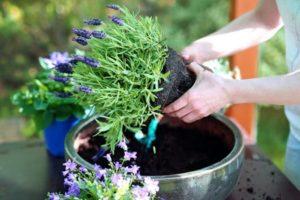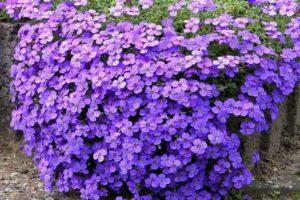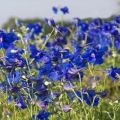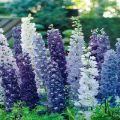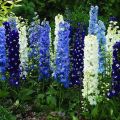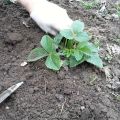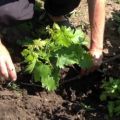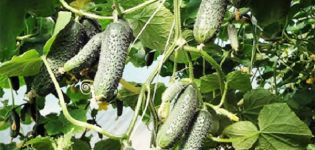What is the best way to transplant a delphinium to a new place in spring, summer and autumn
Delphinium is a flower with an extraordinary name, shape and color options for the petals. There are annual and perennial varieties of delphinium, depending on the choice of which the transplant is different. At the same time, gardeners highlight a number of common criteria. It is about choosing a location, soil composition, fertilization and irrigation.
Features of plant care
Perennial plants tend to grow densely. To see flowering and lush bushes in the future, they are regularly thinned out. During the procedure, special attention is paid to the central part of the bush.
Due to the density of the branches, enough air does not flow to the inside of the bush. It is customary to leave from 3 to 6 branches on one plant. In this case, the weak are cut off, and the well-developed ones are left.
As the plant grows, it is tied to an ordinary stick or any other device. Branches with flowers in some varieties grow up to 55 cm. The strapping is needed so that they are not broken by gusts of wind. The rope for tying is chosen soft and wide enough to exclude the possibility of damage to the delphinium stems.
Flowers that have completed their "mission" spoil the appearance of the plant. They are cut if there is no need to collect seeds. In this case, gardeners should remember that the delphinium has hollow stems. After pruning the branches, the open tube becomes an excellent collection point for rainwater.
In this case, the delphinium often rots. To eliminate this and save the plant, the pipes are covered with clay or split to the root. In this case, it prevents moisture collection.
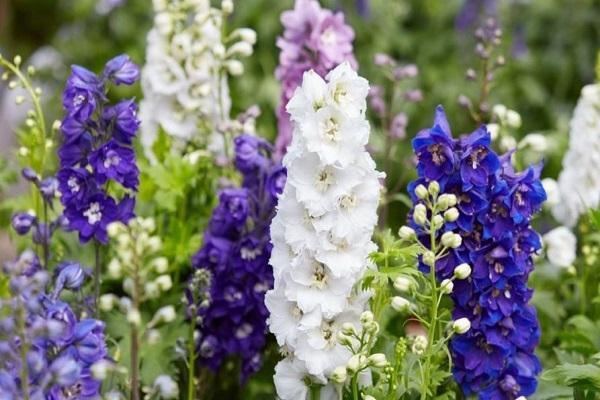
With good and complete care, the flower grows quietly in the garden for 5-6 years.
When can you transplant a perennial delphinium to another place
This question is not asked by amateur gardeners, which cannot be said about professionals. This question, first of all, concerns perennial varieties. As a result of the growth of a delphinium in the same place, the soil under it becomes poorer. Top dressing with fertilizers will not help to avoid this phenomenon.
Delphinium transplant is carried out every 3-4 years. Transferring a plant to a new location promotes abundant flowering. The transplant procedure contributes to the better development of the delphinium.
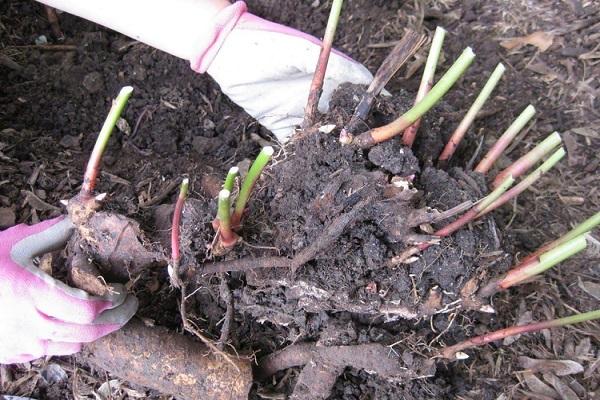
When is the best time to transplant?
Florists engaged in the cultivation of delphiniums do not have a consensus on this issue. Each variety has its own specific period.
Summer
Typically, the plant is transplanted in spring or fall.But this can also be done in the summer season - in August. In this case, the delphinium should bloom. The transplant sequence is the same as in spring or autumn.
In autumn
Delphinium transplant takes place in September. This time is good for plant propagation. The new site is prepared according to all the rules.
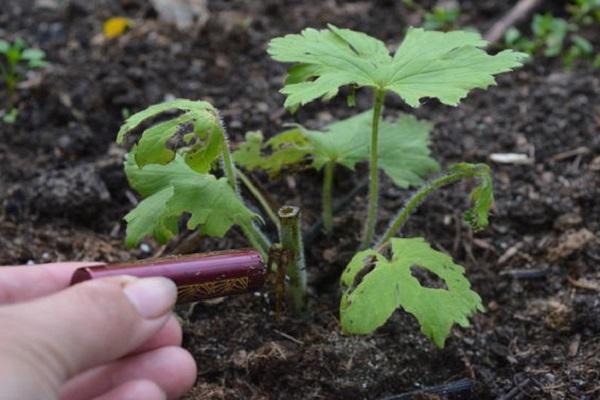
In the spring
Gardeners call this period the most suitable. The procedure is performed in early or mid-April. At the same time, they are waiting for the moment when the late frosts have completely passed. Reasons for transplanting a delphinium to a new location:
- rejuvenation of the bush;
- change of place, since the previous one turned out to be inappropriate;
- planting young shoots.
Florists are advised to pay attention to the autumn transplant. Before the onset of cold weather, the delphinium should develop a root system. Thus, he will endure frost without difficulty.
How to transplant a flower correctly?
The procedure consists of several stages.
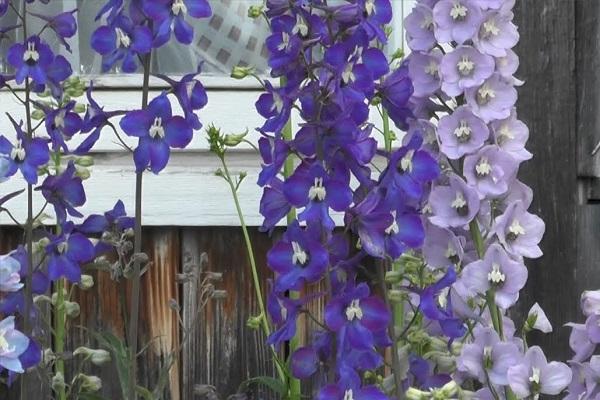
Seat selection
People often underestimate the importance of this point. What are the criteria:
- Delphinium is not planted near the passage of groundwater.
- The plot of land is protected from the wind.
- The place for the flower should be well lit by the sun's rays, and darkened at noon.
- Avoid places with stagnant moisture. If the water is not absorbed into the soil, the roots will rot.
A correctly selected area contributes to the early flowering of the delphinium.
Soil preparation
The best soil for a plant is sandy loam or loamy. It must be enriched with organic matter. Slightly acidic or neutral soils are encouraged. Clay compositions are mixed with minerals and compost.

Transplant technology
The plant transfer procedure is as follows:
- A hole is formed, the depth of which does not exceed the bayonet of the shovel.
- Drainage 15 cm high is laid out on the bottom.
- The soil from the pit is mixed with ash, compost and superphosphate.
- A small amount of earthen mixture is poured onto the sand from above.
- A plant is placed in the hole, spreading the roots.
The rest of the soil is poured into the dug hole. During falling asleep, the delphinium holes are held so that it grows evenly. Similar techniques allow you to place a flower on a hill.
Tips from experienced gardeners
There should be at least 50-55 cm between the transplanted shoots. Often, transplanting is required for adult flowers if the main rules were not taken into account during planting. Transferring the plant to a new place will also help to solve the problem of diseases and changes in appearance.
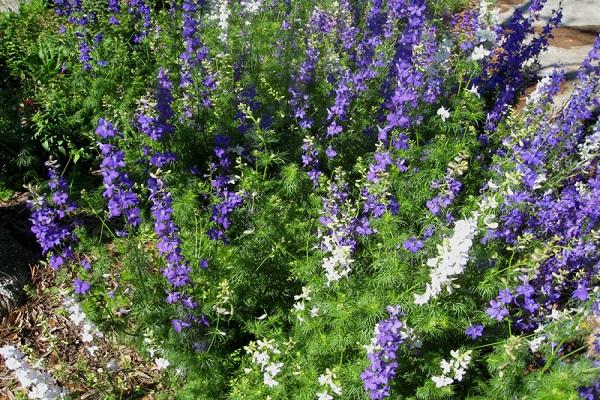
Transplant depending on the age of the flower
The procedure for old bushes has some differences. The actions are as follows:
- After digging out the bushes, they are cut into pieces. Each should have at least 2 shoots.
- Slices are treated with activated charcoal.
- Shake off excess soil from the roots and cut off damaged areas.
- Shoots are planted in containers filled with a mixture of soil, humus and sand.
- Delphinium pots should be kept in the greenhouse for at least 10 days.
After completing all the actions, they begin to plant shoots in the ground.
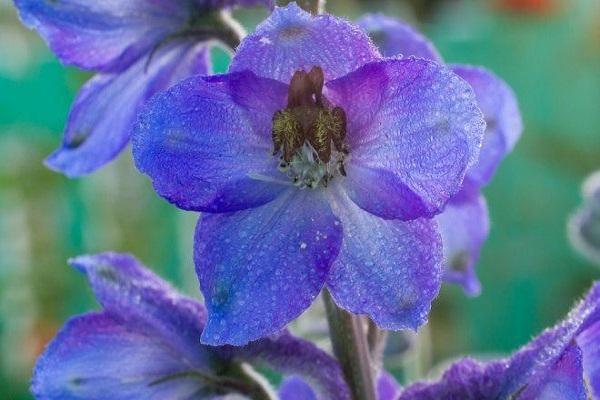
Preparing a place for a young flower is the same as when planting. Fertilizers are applied to the soil and the flower is watered abundantly. Bushes up to 15 cm in height are allowed for replanting.
If a person is experiencing a transplant for the first time, the procedure can be intimidating. The actions that need to be performed are simple and within the power of everyone. A person is required to follow the basic rules so that the flower grows and decorates the garden with its beauty.
